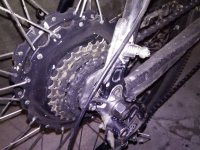HolgiB
10 W
- Joined
- Oct 2, 2018
- Messages
- 70
Hi there,
I am running a 12T MAC on my E-MTB combined with a KT36 20 Amps controller. Following the guidelines / suggestions both from Grin and EBS (www.ebike-solutions.com) I have used dual torque arms like those:
http://www.ebikes.ca/shop/electric-bicycle-parts/torque-arms/torqarm-v4.html


On Sunday I had a flat tire in the rear and needed to disassemble both torque arms somewhere in the wild.
While removing the torque arms with the required tools is not exactly rocket sience, it still takes 5-10 minutes on top compare to fixing a flat tire in the front.
This kept me thinking on my way home:
- Do I really need dual torque arms ?
- Wouldn't one torque arm be sufficient ?
- Should I design an open torque arm from 5-6 mm steel for one side ? Similar to a reinforced dropout ?
As for the open torque arm I could imagine something for the left side screwed to the disc brake mounting holes.
What do you think ?
BTW: I am aware that a spinning hub axles will screw up my dropouts and hence my MTB frame. While I am more a "better safe than sorry" kind of guy, I still could live with some higher risk if this means more convinience for changing a flat tire / tube.
TIA,
Holger
I am running a 12T MAC on my E-MTB combined with a KT36 20 Amps controller. Following the guidelines / suggestions both from Grin and EBS (www.ebike-solutions.com) I have used dual torque arms like those:
http://www.ebikes.ca/shop/electric-bicycle-parts/torque-arms/torqarm-v4.html


On Sunday I had a flat tire in the rear and needed to disassemble both torque arms somewhere in the wild.
While removing the torque arms with the required tools is not exactly rocket sience, it still takes 5-10 minutes on top compare to fixing a flat tire in the front.
This kept me thinking on my way home:
- Do I really need dual torque arms ?
- Wouldn't one torque arm be sufficient ?
- Should I design an open torque arm from 5-6 mm steel for one side ? Similar to a reinforced dropout ?
As for the open torque arm I could imagine something for the left side screwed to the disc brake mounting holes.
What do you think ?
BTW: I am aware that a spinning hub axles will screw up my dropouts and hence my MTB frame. While I am more a "better safe than sorry" kind of guy, I still could live with some higher risk if this means more convinience for changing a flat tire / tube.
TIA,
Holger


